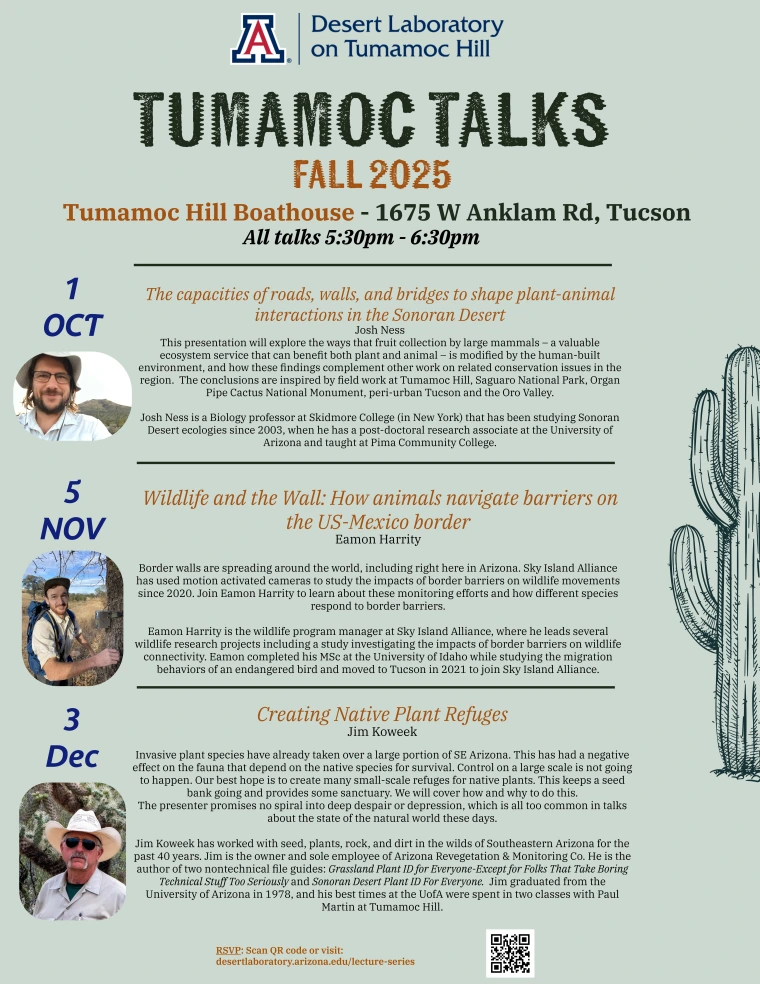The Desert Laboratory on Tumamoc Hill hosts a series of talks focused on topics that relate to the science, ecology, history, and culture of the Sonoran Desert. All talks are open to the public.
Talks are presented in thematic series format in the fall and spring.
Stay Connected
Subscribe to our mailing list to receive notifications about upcoming lectures, events, and field expeditions.
Previous Talks
The theme of this series focuses on water and its significance within the Sonoran Desert.
The theme of this series focuses on water and its significance within the Sonoran Desert.
The theme of this series focuses on water and its significance within the Sonoran Desert.
The theme of this Fall series focuses on water and its significance within the Sonoran Desert.
The theme of this Spring lecture series is resilience in the desert. Dr. Kotutwa Johnson discusses Hopi dry land farming and Dr. Charlotte Brown and Dr. Peter Breslin discuss Sonoran desert plant data reflecting climate change.
The Tumamoc Resilience Garden at the base of Tumamoc Hill will be an inspirational setting where the community can have hands-on participation in how to live in the desert in a hotter and drier future. The backbone design allows passive rainwater harvesting to create an environment that supports a wide diversity of arid-adapted food species from the borderlands. The arid borderlands region is home to dozens of species that are the close relatives of many of the core crops species in use today around the world. These seeds represent millennia of adaptive knowledge from the plants and people of our region. The garden space will weave together time and approaches that demonstrate adaptive responses to an extreme environment, all in an inviting community space.
Health is strongly connected to our interactions with the spaces around us. Tumamoc Hill is emblematic of this relationship, a place where many experience a connection to nature, health, community, self, and others. The importance of these relationships have all been accentuated and challenged in the last year and half. A conscious relationship with the natural world, a critical factor in health, can help alleviate “nature deficit disorder” and help us find balance. Join us for a four-part lecture series that brings together voices in health, environment, community, and food to share emerging perspectives and practical suggestions about the critical role of natural spaces in health and healing.
Agave has been a mainstay of culture in the Americas for millennia: food, drink, tool, spirit, utilitarian, sacred. Adaptations to aridity represented by both agave and people hold critical insights into how to live in the desert. This lecture series looked closely at these adaptations and the reciprocal relationship between this desert plant and people. Through presentations, roundtable discussions, tastings, and art we collectively reconnected to the importance of agave, how this relationship is threatened by climate change and our actions, and also how a resilient future is embedded in the heart of a plant.
For this series, Club Congress and El Crisol offered tastings of agave spirits.
The Santa Cruz River was the life blood of the earliest human settlements in Tucson (Chukshon, O'odham, Black Base) but today has been downcut, drained, channelized, cemented, and ignored. Yet, innovative thinking and actions are working to reverse this trend and revitalize the Santa Cruz river where it once flowed perennially at the base of Tumamoc Hill, reinvigorating a lush ecosystem, the local watershed, and sense of place. This four-part lecture series explored how the river has coursed through the history of people in this region and how it can continue to do so into the future.
Tumamoc Hill | Cemamagi Du’ag has been a site of culture and gathering for thousands of years. In this lecture series we collectively learned from key voices about the vibrancy and essential connection between people and place. We now see the Hill of the Horned Lizard in a different way and appreciate its meaning through the millennia and into the future.
Did you know that the Sonoran Desert originated in part from the tropics? The Río Mayo drainage of the Sierra Madre mountains near Álamos, Sonora, Mexico, is a convergence zone of astonishing biological and cultural diversity. Research into this unique and imperiled ecosystem at the Desert Laboratory on Tumamoc Hill extends back to the 1940s. The Desert Laboratory and The Southwest Center hosted this series, ventured back to the Río Mayo, and heard from a diversity of researchers and community members who highlighted new explorations, biocultural understandings, and efforts to preserve the tropics next door.
La Vaquita Marina, a small porpoise endemic to the upper Gulf of California, is on the precipice of extinction. Global scale economic pressure fuels local gill-net fishing that ensnare the vaquita, driving their numbers down to as few as a dozen individuals remaining. This lecture series with experts from Mexico and the United States explored what lessons we can learn from an intertwined web of science, local and global economics, politics, black markets, and conservation. What can be taken from this dire situation for future conservation? Where does the middle ground exist and how do we get there?
Since the Hornaday expedition set off from the Desert Laboratory in 1907, captured in the book Camp fires on Desert and Lava, there has been a unique connection between Tumamoc Hill and this enigmatic volcanic range in NW Mexico. Recognized by many as the desert’s heart, the Pinacate has captivated and inspired those who have traversed its rugged slopes, peaks, and dunes. Four individuals connected the audience to this special region of our desert in celebration of the first bilingual publication of the 1928 novel Campos de Fuego: A Brief and Fantastic History of an Expedition into the Volcanic Regions of the Pinacate by Gumersindo Esquer, Contribution 2 of the Proceedings of the Desert Laboratory.
Interested in previous one-time lectures given at the Desert Laboratory? Check out our full archive of previous lectures!


